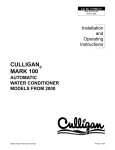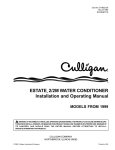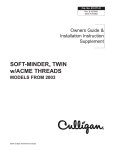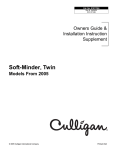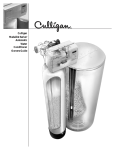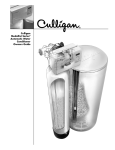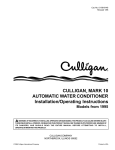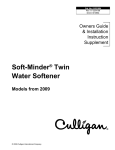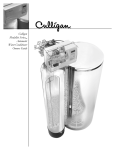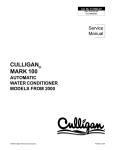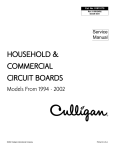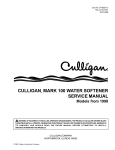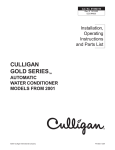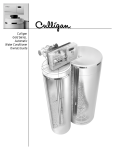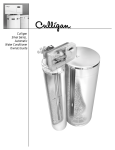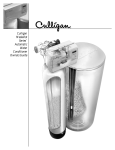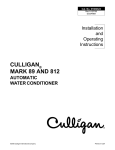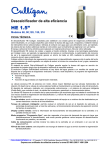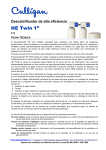Download culligan silver series and gold series
Transcript
Cat. No. 01882344 Rev. A 3/8/01 DCO #2175 Service Manual CULLIGAN SILVER SERIES™ AND GOLD SERIES™ AUTOMATIC WATER CONDITIONER MODELS FROM 2000 ©2001 Culligan International Company Printed in USA Attention Culligan Customer: The installation, service and maintenance of this equipment should be rendered by a qualified and trained service technician. Your local independently operated Culligan dealer employs trained service and maintenance personnel who are experienced in the installation, function and repair of Culligan equipment. This publication is written specifically for these individuals and is intended for their use. We encourage Culligan users to learn about Culligan products, but we believe that product knowledge is best obtained by consulting with your Culligan dealer. Untrained individuals who use this manual assume the risk of any resulting property damage or personal injury. WARNING - Prior to servicing equipment, disconnect power supply to prevent electrical shock. WARNING - If incorrectly installed, operated or maintained, this product can cause severe injury. Those who install, operate, or maintain this product should be trained in its proper use, warned of its dangers, and should read the entire manual before attempting to install, operate or maintain this product. IF THIS EQUIPMENT IS TO BE USED IN THE TREATMENT O F D R I N K I N G W AT E R , T H E W AT E R M U S T B E M I C R O B I O L O G I C A L LY S A F E . Service Manual CULLIGAN SILVER SERIES™ AND GOLD SERIES™ AUTOMATIC WATER CONDITIONER MODELS FROM 2000 Table of Contents Page Introduction ............................................................... 2 Specifications ........................................................... 3 Familiarization ........................................................... 5 Programming ............................................................ 14 Manual Cycling ........................................................ 16 Service Check .......................................................... 17 Parts Replacement Guide ........................................ 18 Board Diagnostics .................................................... 22 Household Aqua-Sensor Sensing Device Troubleshooting Guide .............................................. 23 Aqua-Sensor Troubleshooting Flowchart ................... 25 Troubleshooting Guide .............................................. 26 Wiring Diagram ........................................................ 29 "A" Dimension Charts/Refill Rates ............................ 30 Flow Rate and Drain Line Charts .............................. 32 Flow Charts .............................................................. 34 Introduction The Culligan Silver Series™ and Gold Series™ water softeners are tested and validated by WQA against ANSI/NSF Standard 44 for the effective reduction of calcium and magnesium, along with Barium and Radium 226/228*. SAFE PRACTICES Throughout this manual there are paragraphs set off by special headings. NOTICE: Notice is used to emphasize installation, operation or maintenance information which is important, but does not present any hazard. Example: NOTICE: The nipple must extend no more than 1 inch above the cover plate. CAUTION: Caution is used when failure to follow directions could result in damage to equipment or property. Example: CAUTION: Disassembly while under water pressure can result in flooding. WARNING: Warning is used to indicate a hazard which could cause injury or death if ignored. Example: WARNING! ELECTRICAL SHOCK HAZARD! UNPLUG THE UNIT BEFORE REMOVING THE COVER OR ACCESSING ANY INTERNAL CONTROL PARTS. SERIAL NUMBERS The control valve serial number is located on the back of the timer case. The media tank serial number is located on the top surface of the tank. NOTICE: Do not remove or destroy the serial number. It must be referenced on request for warranty repair or replacement. This publication is based on information available when approved for printing. Continuing design refinement could cause changes that may not be included in this publication. * Verified using hardness surrogate per ANSI/NSF Standard 44. 2 CULLIGAN SILVER SERIES AND GOLD SERIES WATER SOFTENERS Specifications Culligan Silver Series™ Water Conditioners with Time Clock, Aqua-Sensor® Device or Soft-Minder® Meter Control Valve Overall Conditioner Height Media Tank Dimensions (Dia x Ht) Salt Storage Tank Dimensions (Dia x Ht) Exchange Media, Type and Quantity Underbedding, Type and Quantity Exchange Capacity @ Salt Dosage Per Recharge1 Efficiency rated dosage1 Freeboard to Media2 Freeboard to Underbedding3 Salt Storage Capacity Rated Service Flow @ Pressure Drop Total Hardness, Maximum Total Iron, Maximum Hardness to Iron Ratio, Minimum Operating Pressure Operating Temperature Electrical Requirements Electrical Power Consumption, Min/Max Drain Flow, Maximum4 Recharge Time, Average5 Recharge Water Consumption, Average 1 2 3 4 5 9” Model 5-cycle, Reinforced Thermoplastic 51 in 1 295 mm 9 x 45 in 229 x 1 143 mm 16 x 43 in 406 x 1 092 mm 18 x 43 in 457 x 1092 mm Cullex® Media, 0.86 ft3 Cullex® Media, 24.5 L Cullsan® Underbedding, 12 lb Cullsan® Underbedding, 5.4 kg 17,500 gr @ 4.0 lb 1 133 g @ 1.8 kg 23,900 gr @ 8.0 lb 1 547 g @ 3.6 kg 26,600 gr @ 12.0 lb 1 722 g @ 5.4 kg 4 380 gr/lb 655 g/kg 16.6-17.6 in 420-447 mm 39.2 in 996 mm 250 lb or 375 lb 114 kg or 170 kg 7.5 gpm @ 15 psi 30 Lpm @ 102 kPa 75 gpg 1 283 mg/L 5 ppm 5 mg/L 8 gpg to 1 ppm 140 mg/L to 1 mg/L 20-125 psi 140-860 kPa 33-120°F 1-50°C 120V/60 Hz 3 Watts/35 Watts 2.0 gpm 8 Lpm 80 min 40 gal 170 L 12” Model 5-cycle, Reinforced Thermoplastic 51 in 1 295 mm 12 x 45 in 305 x 1 143 mm 18 x 43 in 457 x 1 092 mm Cullex® Media, 1.4 ft3 Cullex® Media, 40 L Cullsan® Underbedding, 30 lb Cullsan® Underbedding, 14 kg 24,100 gr @ 6.0 lb 1 560 g @ 2.7 kg 34,500 gr @ 12.0 lb 2 234 g @ 5.4 kg 41,900 gr @ 18.0 lb 2 713 g @ 8.1 kg 4 010 gr/lb 640 g/kg 17.5-18.5 in 444-470 mm 38.5 in 978 mm 375 lb 170 kg 8.1 gpm @ 15 psi 31 Lpm @ 102 kPa 99 gpg 1 692 mg/L 5 ppm 5 mg/L 8 gpg to 1 ppm 140 mg/L to 1 mg/L 20-125 psi 140-860 kPa 33-120°F 1-50°C 120V/60 Hz 3 Watts/35 Watts 3.5 gpm 14 Lpm 85 min 82 gal 325 L The efficiency rated dosage is only valid at the 4 lb. salt dosage for the 9" models and 6 lb. for the 12" models. Measured from top of media to top surface of tank threads (backwashed and drained). Measured from top of underbedding to top surface of tank threads. Backwash at 120 psi (830 kPa). 10 minute backwash, 4 lb (1.8 kg) 9” model or 6 lb (2.7 kg) 12” model salt dosage. SPECIFICATIONS 3 Culligan Gold Series™ Water Conditioners with Time Clock, Aqua-Sensor® Device or Soft-Minder® Meter Control Valve Overall Conditioner Height Media Tank Dimensions (Dia x Ht) Salt Storage Tank Dimensions (Dia x Ht) Exchange Media, Type and Quantity Underbedding, Type and Quantity Exchange Capacity @ Salt Dosage Per Recharge1 Efficiency rated dosage1 Freeboard to Media2 Freeboard to Underbedding3 Salt Storage Capacity Rated Service Flow @ Pressure Drop Total Hardness, Maximum Total Iron, Maximum Hardness to Iron Ratio, Minimum Operating Pressure Operating Temperature Electrical Requirements Electrical Power Consumption, Min/Max Drain Flow, Maximum4 Recharge Time, Average5 Recharge Water Consumption, Average 1 2 3 4 5 9” Model 5-cycle, Reinforced Thermoplastic 52 in 1 320 mm 9 x 45 in 229 x 1 143 mm 16 x 43 in 406 x 1 092 mm 18 x 43 in 457 x 1092 mm Cullex® Media, 1.00 ft3 Cullex® Media, 28.32 L No Underbedding No Underbedding 18,200 gr @ 4.0 lb 1 179 g @ 1.8 kg 27,300 gr @ 8.0 lb 1 769 g @ 3.6 kg 30,900 gr @ 12.0 lb 2 002 g @ 5.4 kg 4 550 gr/lb 655 g/kg 13.5-15.5 in 343-394 mm No Underbedding No Underbedding 250 lb or 375 lb 114 kg or 170 kg 9 gpm @ 15 psi 30 Lpm @ 102 kPa 75 gpg 1 283 mg/L 5 ppm 5 mg/L 8 gpg to 1 ppm 140 mg/L to 1 mg/L 20-125 psi 140-860 kPa 33-120°F 1-50°C 120V/60 Hz 3 Watts/35 Watts 2.0 gpm 8 Lpm 68 min 43 gal 162 L 12” Model 5-cycle, Reinforced Thermoplastic 52 in 1 320 mm 12 x 45 in 305 x 1 143 mm 18 x 43 in 457 x 1 092 mm Cullex® Media, 1.5 ft3 Cullex® Media, 42.48 L Cullsan® Underbedding, 30 lb Cullsan® Underbedding, 14 kg 26,900 gr @ 6.0 lb 1 743 g @ 2.7 kg 39,600 gr @ 12.0 lb 2 566 g @ 5.4 kg 45,400 gr @ 18.0 lb 2 942 g @ 8.1 kg 4 483 gr/lb 640 g/kg 13.0-15.0 in 330-381 mm 37.0 in 940 mm 375 lb 170 kg 10.5 gpm @ 15 psi 31 Lpm @ 102 kPa 99 gpg 1 692 mg/L 5 ppm 5 mg/L 8 gpg to 1 ppm 140 mg/L to 1 mg/L 20-125 psi 140-860 kPa 33-120°F 1-50°C 120V/60 Hz 3 Watts/35 Watts 3.5 gpm 14 Lpm 57 min 83 gal 314 L The efficiency rated dosage is only valid at the 4 lb. salt dosage for the 9" models and 6 lb. for the 12" models. Measured from top of media to top surface of tank threads (backwashed and drained). Measured from top of underbedding to top surface of tank threads. Backwash at 120 psi (830 kPa). 10 minute backwash, 4 lb (1.8 kg) 9” model or 6 lb (2.7 kg) 12” model salt dosage. 4 CULLIGAN SILVER SERIES™ AND GOLD SERIES WATER SOFTENERS Familiarization CONTROL The Culligan Silver Series™ and Gold Series™ water softener uses the same power valve control as in our Culligan Mark 89/812 models. It can be programmed as either a time clock, Aqua-Sensor® sensing device or Soft-Minder® meter model. Each model has its own programming parameters which can be set to control the operation and regeneration of the system. These functions are outlined in Table 1. TABLE 1 Function 1. Time of Day 2. Time of Regen. 3. Not Used 4. Salt Dosage 5. Backwash Time 6. Brine Rinse Time 7. Hardness Level 8. Gallons Capacity / Regen. Interval 8A. Forced Regeneration Interval 9. Lock/Unlock display 10. Blanking Feature Time Clock YES YES NO YES YES YES NO YES NO YES YES Soft-Minder Meter YES YES NO YES YES YES YES YES YES* YES YES Aqua-Sensor Sensing Device YES YES NO YES YES YES NO NO YES* YES YES * When dip switch #10 is in the ON position During the programming stage, the user will be prompted to enter the appropriate parameter. Refer to the programming section for further information. CIRCUIT BOARD The AccuSoft™ microprocessor circuit board controls every function of the Culligan Silver Series and Gold Series water softeners. This board has several unique features which allow it to perform a variety of functions. Familiarization of the board is essential for a thorough understanding of the softener. The AccuSoft circuit board has a set of default settings that the microprocessor will reset to whenever any dip switches are flipped, or if a meter or Aqua-Sensor cable is attached or removed while the power is on the control. Table 2 is a list of the default microprocessor settings. It is recommended to always disconnect the power from the circuit board prior to replacing an Aqua-Sensor probe or Meter cable so that the programmed settings are not lost. TABLE 2 1 2 3 4 5 6 7 8 9 10 Time of Day Time of Regeneration Chlorination (Not Used) Salt Dosage Backwash Time Brine Rinse Hardness Regeneration Interval Display Blanking Display Lock Out 12:00 A.M. 2:00 A.M. 10 min. 10 lb. for 9"; 16 lb. for 12" 10 min. 71 min. for 9"; 59 min. for 12" 20 GPG 3 days Enabled Disabled FAMILIARIZATION 5 PROGRAMMING SWITCHES The circuit board will require the proper setting of the dip switches in order to function properly. Figure 1 shows the dip switches. Switch 1 - Sets the unit in the Run or Test mode. Switch 2 - Sets the unit for Filter or Softener. Switch 3 - Sets the flow meter K factor for the 3/4" or 1-1/4" flow meter. Switch 4 - Sets the control for 9” or 12” diameter tanks. Switch 5 - Sets the unit for the standard or accelerated Refill cycle. NOTICE: For an accelerated Refill cycle, the refill flow control in the brine refill assembly must be changed to PN 00-4016-23. Switch 6 - Sets the unit for immediate or delayed regeneration. Switch 7 - Sets the unit to measure in liters and French or German hardness, or in gallons and the conventional gpg hardness. Switch 8 - Sets the unit to display time with a 24 or 12 hour clock. Switch 9 - Sets the unit for either French or German hardness degrees when switch #7 is in the ON position. Switch 10 - When turned ON, the microprocessor will force a regeneration based on the setting 8A in the menu. Dip Switch Function Default (OFF) Position 1 Run or Test Mode Run Mode 2 Filter or Softener Softener 3 Flow Meter K Factor (3/4" or 1-1/4") 3/4" Flow Meter 4 9" - 12" Tank Settings 9" Tank 5 Standard vs. Accelerated Refill Standard Refill 6 Delay vs. Immediate Regeneration Delayed Regeneration 7 English vs. Metric Settings English Settings 8 12 or 24 Hour Clock 12 Hour Clock 9 German or French Hardness Degrees German (When #7 is ON) 10 Time Clock Backup No Forced Regeneration FIG. 1 AUXILIARY CONNECTIONS Refer to Figure 2 for all circuit board connections. Power terminals are located along the lower section of the circuit board. The connection marked 'POWER' is for the transformer connector, and the motor connection is marked 'MOTOR'. The connection for the cam switch harness, marked 'CAM', is located in the upper right corner near the dip switches. The Aqua-Sensor sensing device connection is located in the lower center of the board, just above the power connectors, while the SoftMinder connection is located in the upper left side of the board. Just below the meter connection is a connection marked 'BATT', which is for the optional battery back-up. All terminals are clearly marked to ease installation. FIG. 2 6 CULLIGAN SILVER SERIES™ AND GOLD SERIES™ WATER SOFTENERS AQUA-SENSOR® OPERATION The Aqua-Sensor Sensing Device utilizes a pair of cells to sense the passage of hardness through the water softener. It can automatically adjust for water with variable hardness levels. As a result, it is the most efficient means of operating a water softener. When hardness is sensed, the unit signals for a regeneration. The "REGEN" enunciator will light at this point. The unit will perform a standard regeneration cycle at the preset time, unless the number 6 dip switch is turned on. When the number 6 dip switch is in the "ON" position, a regeneration will begin immediately. The Aqua-Sensor models contain a feature which can automatically detect when the brine solution has been rinsed through the Cullex® media. This feature will advance the control to the next position when it senses that the brine has been rinsed out prior to the time set in the Brine/Rinse option. Tables 3A and 3B show the total capacity of the Aqua-Sensor at various salt dosages, along with the average capacity used prior to a signal calling for regeneration. Since the Aqua-Sensor device automatically senses hardness in the water, the programming is limited to the Timeof-Day, Time-of-Regeneration, Salt Dosage, Backwash Time and Brine/Rinse settings. The numeric enunciator will only light for those programming options (numbers 1-6, 9, and 10). Refer to the programming section for further information on programming the microprocessor. SOFT-MINDER® OPERATION The Soft-Minder meter utilizes a turbine impeller to accurately monitor the customers water usage. After a predetermined amount of water has passed through the system, the microprocessor will signal a regeneration. The "REGEN" enunciator will light at this point. The unit will perform a standard regeneration cycle at the preset time, unless the number 6 dip switch is turned on. When the number 6 dip switch is in the "ON" position, a regeneration will begin immediately. The microprocessor automatically calculates the gallons of water which can be treated based on the salt dosage, the water hardness, and the tank size. Refer to Tables 4B and 5B for capacity and reserve values that the microprocessor will use based on its settings. The GALLONS TO SIGNAL setting can be manually set to directly override the microprocessor calculations. This setting can be modified when positioned at numeric enunciator 8. The gallon value may need to be raised or lowered to meet the needs of your specific application. The control must be cycled through a complete regeneration before the gallon override setting is stored by the microprocessor. NOTICE: Changing the capacity will affect the reserve capacity. An INCREASE in the gallons capacity will DECREASE the reserve capacity. A DECREASE in the gallons capacity will INCREASE the reserve capacity. Refer to Tables 4B and 5B to determine the units total capacity based on salt dosage and the hardness level. The programming of the Soft-Minder provides several settable variables, the Time-of-Day, Time-of-Regeneration, Salt Dosage, Backwash Time, Brine/Rinse Time, Hardness, and Gallons to Signal. The numeric enunciator will light for programming sequences 1-10. Refer to the programming section for further information on programming the microprocessor. NOTICE: Dip switch #3 needs to be in the "ON" position for the meter to correctly count gallons. TIME CLOCK OPERATION When the microprocessor is set-up as a time clock unit, the Culligan Silver Series™ and Gold Series™ control will regenerate at fixed intervals which are determined by the water hardness, the salt dosage, and the household's water usage. To calculate the regeneration interval, locate the total gallon capacity in Table 4B and 5B based on the salt dosage and the water hardness. Divide the units total capacity by the anticipated daily gallon usage for the household. This value is the regeneration interval, always round this value up to the nearest whole number. This regeneration interval can be set anywhere from 1 to 42 days. The programming for the time clock models is limited to Time-of-Day, Time-of-Regeneration, Salt Dosage, Backwash Time, Brine/Rinse Time, and the Regeneration Interval. The numeric enunciator will only light for those programming options (number 1-6, and 8-10). Refer to the programming section for further information on programming the microprocessor. FAMILIARIZATION 7 CAPACITY AND SALT SETTINGS The current software calculates the gallon capacities based on the yoke style tanks. The yoke style tanks have 0.86 ft3 of Cullex® resin in the 9" tanks and 1.4 ft3 of Cullex resin in the 12" tanks, whereas the new center opening tanks have 1.0 ft3 in the 9" tanks and 1.5 ft3 of Cullex resin in the 12" tanks. To take advantage of the additional capacities obtained with the added resin follow the procedure listed below for calculating the capacity settings. 1. Compensated Water Hardness. If your water supply contains iron, compensate for it by the following procedure: 1. Multiply the iron by 0.1 and add the result to the hardness. Example: (3 ppm of iron x 0.1) + 25 gpg of hardness = 25.3 gpg of total hardness 2. Choose the % capacity you want and refer to the table below for the appropriate multiplier. Example: 67% capacity gives a multiplier of 1.5. TABLE 3 % Capacity Multiplier 50% 67% 75% 2 1.5 1.33 3. Multiply the result from Step 1 by the multiplier chosen in Step 2. This is the compensated hardness. Example: 25.3 gpg total hardness x 1.5 = 38 gpg compensated hardess. 4. Use the effective hardness for sizing and to determine salt dosage and regeneration frequency. 5. The forced regeneration feature should be used for Soft-Minder meter operation to ensure the resin bed does not become iron fouled due to lack of water flow. See "Programming the Option Settings" for the forced regeneration feature. 2. Salt Dosage From Table 4, select the salt dosage at which the softener will be operated. • Low Setting — Maximum salt efficiency, more frequent regeneration, reduced overall softening capacity. • Medium Setting — Good combination of efficiency and overall softening capacity. • High Setting — Maximum softening capacity, less frequent regeneration, and reduced salt efficiency. Recommended whenever iron is present and for hardness levels above 30 Grains Per Gallon, or high volume water usage. TABLE 4 - SALT DOSAGE Capacity Salt Capacity Dosage 9" Tank 12" Tank 4 18,200 X 5 21,500 27,000 6 23,500 29,600 7 25,000 31,400 8 27,300 33,100 9 27,800 34,700 10 28,900 36,300 11 30,000 37,500 12 30,900 39,600 13 31,900 40,000 14 32,700 41,000 15 33,500 42,000 16 X 42,900 17 X 43,700 18 X 45,400 19 X 45,500 20 X 46,100 8 160 lb. Brine Tank "A" Dimension Secondary (Only) in. (cm) 7-3/4 19.7 9-1/2 24.1 11-1/4 28.6 13 33 14-3/4 37.5 16-1/2 42 18-1/4 46.3 20 51 21-3/4 55.2 21-1/2 59.7 25-1/4 64.1 — — — — — — — — — — — — 250 lb. Brine Tank "A" Dimension Secondary Primary in. (cm) in. (cm) 6-5/8 16.8 4-5/8 11.7 8 20.3 6 15.2 9-3/8 23.8 7-3/8 18.7 10-7/8 27.6 8-7/8 22.5 12-1/4 31.1 10-1/4 26 13-5/8 34.6 11-5/8 29.5 15 38.1 13 33 16-3/8 41.6 14-3/8 36.5 17-3/4 45.1 15-3/4 40 19-1/8 48.6 17-1/8 43.5 20-1/2 52.1 18-1/2 47 21-7/8 55.5 19-7/8 50.5 23-1/4 59 21-1/4 54 24-5/8 62.5 22-5/8 57.5 26 66 24 61 27-3/8 69.5 25-3/8 64.5 28-3/4 73 26-3/4 68 CULLIGAN SILVER SERIES AND GOLD SERIES WATER SOFTENERS 375 lb. Brine Tank "A" Dimension Secondary Primary in. (cm) in. (cm) 5-1/2 14.0 3-1/2 8.9 6-1/2 16.5 4-1/2 11.4 7-1/2 19 5-1/2 14 8-1/2 21.6 6-1/2 16.5 9-1/2 24.1 7-1/2 19 10-1/2 26.7 8-1/2 21.6 11-1/2 29.2 9-1/2 24.1 12-1/2 31.7 10-1/2 26.7 13-1/2 34.3 11-1/2 29.2 14-1/2 36.8 12-1/2 31.7 15-1/2 39.4 13-1/2 34.3 16-1/2 42 14-1/2 36.8 17-1/2 44.5 15-1/2 39.4 18-1/2 47 16-1/2 42 19-1/2 49.5 17-1/2 44.5 20-1/2 52.1 18-1/2 47 21-1/2 54.6 19-1/2 49.5 3. Treated Water Volume Set Point Calculate the treated water volume set point using the following information: • Softening capacity — Grains (based upon salt dosage setting). • Compensated hardness of water supply — Grains Per Gallon • Estimated daily water usage — Gallons Per Day (refer to Table 5) TABLE 5 - Daily Water Usage Persons in Household 2 3 4 5 6 7 8 9 10 Gallons Per Day 150 225 300 375 450 525 600 675 750 Example - Soft-Minder® Meter Models Capacity @ 8 lb. Salt Dosage: 27,300 Grains Compensated Water Hardness: 19 Grains Per Gallon Estimated Daily Water Usage: 300 Gallons Per Day Treated Water Volume Set Point = Softener Capacity — Water Usage Compensated Hardness Softening Capacity Divide by Compensated Hardness Result is total number of gallons of soft water per regeneration Subtract daily Water Usage (needed as a reserve to ensure continuous soft water until regeneration occurs). Round down to nearest ten for Treated Water Volume Set Point Set numeric enunciator number 8 to 113 27,300 Grains ÷ 19 Grains per Gallon 1,437 Gallons — 300 Daily Water Usage (One Day Supply) 1,137 Gallons 1,137 Gallon Setting Example - Timeclock Model Capacity @ 8 lb. Salt Dosage: 27,300 Grains Compensated Water Hardness: 19 Grains Per Gallon Estimated Daily Water Usage: 300 Gallons Per Day Softener Capacity Treated Water Volume Set Point = Compensated Hardness — Water Usage Softening Capacity Divide by Compensated Hardness Result is total number of gallons of soft water per regeneration Subtract daily Water Usage (needed as a reserve to ensure continuous soft water until regeneration occurs). Divide by daily water usage Round down to nearest day Set numeric enunciator number 8 to 3 27,300 Grains ÷ 19 Grains per Gallon 1,437 Gallons — 300 Daily Water Usage (One Day Supply) 1,137 Gallons ÷ 300 3.8 Days 3.0 Days FAMILIARIZATION 9 Use the following worksheets to calculate and record the proper settings. Treated Water Volume Set Point Work Sheet - Meter Models 1. Enter Softening Capacity 2. Divide by Compensation Hardness Result is Total Gallons of Soft Water Per Regeneration 3. Subtract Daily Water Usage (Reserve Result ÷ = — = Round down to nearest ten for Treated Water Volume Set Point Gallons Treated Water Volume Set Point Work Sheet - Timeclock Models 1. Enter Softening Capacity 2. Divide by Compensation Hardness Result is Total Gallons of Soft Water Per Regeneration ÷ = 3. Subtract Daily Water Usage (Reserve — 4. Divide by Daily Water Usage ÷ Result Round down to nearest ten for days between regeneration set point = Days Note: All Softening capacity is based on using sodium chloride as the regenerate: If potassium chloride is used reduce the rated softening capacity by 20%. All capacities are based on new Cullex®. REGENERATION There are several conditions that will cause the control to trip a regeneration. The 'REGEN' enunciator will light when the control has signaled for a regeneration. The 'REGEN' enunciator will flash while the control is in regeneration. The following are conditions that will call for regeneration: 1. 2. 3. 4. 5. 6. 7. When the Aqua-Sensor® probe senses the hardness in the Cullex® media. When the Soft-Minder® meter has recorded the passage of a predetermined number of gallons. When the time clock has counted past the set number of days. At the preset time, when the number of days without a regeneration is equal to the days set in menu #8A. At the preset time, when the 'REGEN.’ button is depressed once. 'REGEN.' will light. Immediately, when the ‘REGEN.” button is depressed twice. 'REGEN.' will light and blink. Immediately, if power to the unit has been off for more than 3 hours. If dip switch 6 is in the ON position the unit will begin a regeneration immediately for instances 1 and 2. With dip switch 6 in the OFF position, the regeneration will not begin until the preset regeneration time. DISPLAY BLANKING As shipped from the factory, the display of the board will turn off if there has been no keypad activity for a 1 minute period. To have the display constantly lit, press the STATUS button until the number 10 icon is lit. Next, press the UP arrow. A “d” for disable will appear in the display. To have the display blank again , press the UP arrow. An “E” will appear in the display . 10 CULLIGAN SILVER SERIES AND GOLD SERIES WATER SOFTENERS DISPLAY LOCKOUT The Culligan Silver Series™ and Gold Series™ control is equipped with a feature which will allow you to protect the programmed settings from tampering by unauthorized individuals. When the lockout feature is activated, the only parameter which can be adjusted is the Time-of-Day. To activate the lockout feature, press the STATUS button until the number 9 icon is illuminated. A “U” for unlock will be displayed. Press the UP and DOWN arrows simultaneously. A “L” for lock will appear along with an icon of a lock. All program parameters, except time of day, are now frozen at their current settings. To disable this feature, press the UP and DOWN arrows simultaneously. POWER LOSS The AccuSoft® circuit board is equipped with a Hi-Cap Capacitor and EEPROM memory chip. The capacitor is capable of maintaining the time, for at least one day, in the event of a power outage. The EEPROM ensures that the individual programming parameters of the softener are not lost. If the power outage lasts long enough to drain the Hi-Cap Capacitor, the control will flash "12:00 PM" when power is returned to the control. The unit will continue to keep time from the moment power is restored, and will initiate a full regeneration at the preset regeneration time. The time of day will need to be reset in order to return the regeneration to its preset time. FAILURE MODE The Culligan Silver Series and Gold Series control is equipped to detect a motor or piston which is locked in a frozen position. The AccuSoft™ circuit board will apply power to the motor for 30 seconds. If there is no change in the motor homing or position switch, the control will power down for 90 seconds. The circuit board will repeat this procedure two more times in an attempt to remove the obstruction. If no movement has been detected, the control will permanently power down and a phone icon will appear in the display. The phone indicates that a service call is required to fix the control. To return to the service mode, turn off the power to the unit for 1 full minute and remove the obstruction to the motor or piston. FAMILIARIZATION 11 12 CULLIGAN SILVER SERIES™ AND GOLD SERIES™ WATER SOFTENERS (37.5) 15-3/4 (40.0) 21-3/4 (55.2) 375 LB (26.9) 11-3/8 (19.1) 7-1/2 IN (CM) TOTAL CAPACITY CAPACITY TO SIGNAL TOTAL CAPACITY CAPACITY TO SIGNAL (11.7) (19.7) 12 8 4-5/8 7-3/4 4 (40.0) (55.2) (23.5) 15-3/4 (37.5) 21-3/4 9-1/4 14-3/4 IN (CM) IN (CM) DOSAGE 250 LB 160 LB SALT "A" DIMENSION (26.9) 11-3/8 (19.1) 7-1/2 (8.9) 3-1/4 IN (CM) 375 LB CAPACITY TO SIGNAL TOTAL CAPACITY CAPACITY TO SIGNAL TOTAL CAPACITY CAPACITY TO SIGNAL TOTAL CAPACITY TABLE 6B - CAPACITY, 9" SOFT-MINDER® METER (GALLONS) 12 9-1/4 (23.5) 14-3/4 8 250 LB IN (CM) 160 LB IN (CM) SALT DOSAGE "A" DIMENSION 6-10 707 980 849 637 805 731 813 631 980 495 644 3,656 1,828 1,195 896 696 5,420 2,710 1,807 1,355 1,084 3,314 1,657 1,084 4,900 2,450 1,633 1,225 2,596 1,298 914 609 903 590 817 457 678 442 613 406 602 393 544 HARDNESS 522 774 505 700 366 542 354 490 332 493 322 445 305 452 281 417 261 387 244 301 580 903 526 817 412 537 487 774 442 700 426 678 387 613 367 602 333 544 331 542 300 490 294 493 267 445 270 452 246 417 229 387 209 361 11-15 16-20 21-25 26-30 31-35 36-40 41-45 46-50 51-55 56-60 61-65 66-70 71-75 3,220 1,610 1,073 6-10 3,656 1,828 1,219 5,420 2,710 1,807 1,355 1,084 3,537 1,949 1,179 1,004 1-5 HARDNESS 11-15 16-20 21-25 26-30 31-35 36-40 41-45 46-50 51-55 56-60 61-65 66-70 71-75 4,900 2,450 1,633 1,225 1-5 TABLE 6A - CAPACITY, 9" AQUA-SENSOR® SENSING DEVICE (GALLONS) FAMILIARIZATION 13 375 LB 17-1/4 (43.8) 24-1/2 (62.2) (28.9) 11-3/8 IN (CM) TOTAL CAPACITY CAPACITY TO SIGNAL TOTAL CAPACITY CAPACITY TO SIGNAL (18.7) (37.5) 18 12 7-3/8 14-3/4 6 (43.8) (62.2) (28.9) 17-1/4 (40.0) 11-3/8 (14.0) 5-1/2 IN (CM) 375 LB 24-1/2 (56.2) N/A 15-3/4 21-3/4 IN (CM) IN (CM) DOSAGE 250 LB "A" DIMENSION 160 LB SALT CAPACITY TO SIGNAL TOTAL CAPACITY CAPACITY TO SIGNAL TOTAL CAPACITY CAPACITY TO SIGNAL TOTAL CAPACITY 1-5 6-10 HARDNESS 908 757 649 6-10 867 650 958 578 851 505 749 HARDNESS 743 568 843 520 766 454 674 433 638 379 562 371 547 479 325 426 289 383 260 857 666 555 753 920 767 644 963 466 646 5,346 2,673 1,748 1,311 1,018 849 713 7,660 3,830 2,553 1,915 1,532 1,277 1,094 4,832 2,416 1,580 1,185 6,740 3,370 2,247 1,685 1,348 1,123 3,495 1,748 1,143 904 624 958 564 843 408 565 537 851 486 749 484 766 437 674 395 638 357 562 335 547 286 479 246 426 219 383 11-15 16-20 21-25 26-30 31-35 36-40 41-45 46-50 51-55 56-60 61-65 66-70 71-75 4,520 2,260 1,507 1,130 1-5 5,200 2,600 1,733 1,300 1,040 7,660 3,830 2,553 1,915 1,532 1,277 1,094 4,542 2,271 1,514 1,136 963 11-15 16-20 21-25 26-30 31-35 36-40 41-45 46-50 51-55 56-60 61-65 66-70 71-75 6,740 3,370 2,247 1,685 1,348 1,123 TABLE 7B - CAPACITY, 12" SOFT-MINDER® METER (GALLONS) N/A (40.0) (56.2) 18 15-3/4 21-3/4 12 250 LB IN (CM) 160 LB IN (CM) SALT DOSAGE "A" DIMENSION TABLE 7A - CAPACITY, 12" TIMECLOCK AND AQUA-SENSOR® SENSING DEVICE (GALLONS) Programming The display will initially power up flashing "12:00 PM". After 1 minute the motor will energize and cycle the control, without stopping, to the home position. This is required to ensure that the control is in the home position. FIG. 3 - Circuit Board Display The timer uses four buttons: 1. 2. 3. 4. STATUS: UP ARROW: DOWN ARROW: REGEN.: Advance timer through display options. Increase the setting. Decrease the setting. Initiate a manual regeneration. SETTING THE MICROPROCESSOR The microprocessor senses when it is installed as a Soft-Minder or Aqua-Sensor® control. Adding or removing any connection to the board, or flipping any of the dip switches will automatically reset the microprocessor to the factory settings. 1. 2. 3. 4. 5. With a flashing or blank display, pressing the status button twice will move to the Time-of-Day adjustment, adjust the time by using the up and down arrows. A number “1” will appear at the bottom of the display while in this mode. Press ▲ to increase or ▼ to decrease Press ▲ to increase or ▼ to decrease Press ▲ to increase or ▼ to decrease Press ▲ to increase or ▼ to decrease Press ▲ to increase or ▼ to decrease Press status again, this displays the Time-of-Regeneration for delayed units, adjust using the up and down arrows. A number “2” will appear at the bottom of the display while in this mode. Press status again, the number “3” will appear at the bottom of the display. This setting is not used, and any changes made will not affect the operation of the microprocessor. Pressing status again will show the Salt Dosage. This can be adjusted with the up and down arrows, the range is 3-15 lbs. for the 9” controls and 5-24 lbs. on 12” controls. A number “4” will appear at the bottom of the display while in this mode. Press status again, this displays the Backwash Time in minutes. The setting can be adjusted between 5 and 40 minutes by using the up and down arrows. A number “5” will appear at the bottom of the display while in this mode. 14 CULLIGAN SILVER SERIES™ AND GOLD SERIES™ WATER SOFTENERS 6. 7. 8. Press status again to display the Brine/Rinse Time in minutes. The settings can be adjusted using the up and down arrows (37-85 min for 9”, 35-89 min for 12”). A number “6” will appear at the bottom of the display while in this mode. Press ▲ to increase or ▼ to decrease Press status again to display the Hardness Level in grains per gallon. The setting can be adjusted from 2-99 gpg by using the up and down arrows. This screen will not appear when the Aqua-Sensor® probe is attached. A number “7” will appear at the bottom of the display while in this mode. Press ▲ to increase or ▼ to decrease Press status again, for time clock models the display will show the Regeneration Interval. The setting can be adjusted using the up and down arrows. Controls with a Soft-Minder® meter will display the Gallons to Signal (multiply the displayed value by 10). A number “8” will appear at the bottom of the display while in this mode. Press ▲ to increase or ▼ to decrease Press ▲ to increase or ▼ to decrease Press ▲ simultaneously ▼ Press ▲ to change 8A. Display menu '8A' will light when dip switch #10 is in the ON position. This is the Time Clock Backup feature. The control will force a regeneration, within a range of 1-42 days, when in the Aqua-Sensor® or Soft-Minder® meter mode. 9. Pressing status again will display the Lock/Unlock feature. A “U” in the display signifies an unlocked microprocessor, while a “L” will lock the settings except for the time of day. To toggle between the two settings press both arrow keys simultaneously. A number “9” will appear at the bottom of the display while in this mode. 10. Pressing status again brings up the ability to Enable/Disable the screen blanking. To have the display constantly lit, press the up arrow, a “d” for disable will appear in the display. Pressing the up arrow again displays an “E”, signifying that display blanking is enabled. A number “10” will appear at the bottom of the display while in this mode. NOTICE: Programming changes are not locked into the microprocessor memory until the control completes a regeneration cycle. To initiate a manual regeneration, press the REGEN. button twice, the "REGEN" enunciator will flash on the display. Refer to the Manual Cycling section on how to step through the regeneration stages. PROGRAMMING 15 Manual Cycling The Culligan® microprocessor can be indexed through the various regeneration stages. For all steps, the cycle numbers do not appear, or change, until the motor stops. 1. Press the status button to move past steps 1-10 until the display is blank. Push the up arrow. The number “11” icon will light up. An "H" will appear in the display. The control is in the HOME position. Pressing the regen button once will light the 'REGEN' icon. 2. Press the regen button one more time. The 'REGEN' icon will blink, and the motor will advance the control. A '1' will appear. The unit is now in the BACKWASH position. The numbers to the right indicate the time remaining for the cycle. 3. Press the up arrow. A '2' will appear in the display, along with the cycle time remaining. The control is in the BRINE DRAW/SLOW RINSE cycle. 4. Press the up arrow. A '3' will appear in the display, along with the cycle time remaining. The control is in the FAST RINSE/BRINE REFILL cycle. 5. Press the up arrow. An 'H' will appear in the display. The unit is in the HOME position. The 'REGEN' enunciator is no longer blinking. An 'H 20' will appear on the Aqua-Sensor® models. 6. Press the status key. Time-of-Day appears in the display. 16 CULLIGAN SILVER SERIES™ AND GOLD SERIES™ WATER SOFTENERS Service Check The service check mode allows one to view the instantaneous flow rate, the days since the last regeneration, the total number of regenerations, the regenerations in the past fourteen days, and the gallons remaining. To enter the service check mode, follow these steps: 1. Press the status key to move past steps 1-10 until the display is blank. 2. Push the down arrow. The number '12' will appear only when the Soft-Minder® meter is connected. The display reads the gallons per minute flow rate. This screen will update with the current meter reading every 6 seconds. 3. Press the down arrow. The number '13' and an "A" will light at the bottom of the display. The display will indicate the number of regenerations that have occurred in the last 14 days. 4. Press the down arrow. The number '13' and a 'B' will light at the bottom of the display. The display will indicate the total number of regenerations this control has cycled through. 5. Press the down arrow. The number '14' will light at the bottom of the display. The number in the display indicates the number of days since last regeneration. 6. Press the down arrow. The number '15' will be displayed if the flow meter or Aqua-Sensor® is connected. For the controls with the Soft-Minder® meter, the display indicates the gallons remaining before the unit signals for regeneration (multiply the displayed number by 10). For Aqua-Sensor® controls, the number indicates the total minutes of the last brine rinse cycle. NOTICE: Pushing the up arrow at any of these displays will immediately bring you to the control position display, the number '11' will light at the bottom of the display. SERVICE CHECK 17 Parts Replacement Guide Familiarize yourself with the replacement procedures and component parts thoroughly before attempting any repair. WARNING! DISCONNECT ALL ELECTRICAL POWER TO THE UNIT BEFORE SERVICING. BYPASS THE UNIT AND RELIEVE SYSTEM PRESSURE BEFORE ATTEMPTING REPAIR. CIRCUIT BOARD To replace the AccuSoft™ circuit board, refer to the parts list and proceed as follows: 1. Remove the timer cover be removing the two screws located in the front of the cover. 2. Swing the circuit board mounting plate out, and lift it off of the two hinge posts. 3. Remove all connected wire leads from the board. CAUTION: Grip all connections to the circuit board by the connecting terminals for assembly and disassembly. Failure to do so could result in damage to the wire leads or connecting terminals 4. Remove the four screws holding the board to the mounting plate. See Figure 4. CAUTION: Do not touch any surfaces of the circuit board. Electrical static discharges may cause damage to the board. Handle the AccuSoft™ circuit board by holding olny the edges of the circuit board. Keep replacement boards in their special anti-static bags until ready for use. Mishandling of the circuit board will void the warranty. 5. The new circuit board can be installed by reversing the steps 1-4 above. CAUTION: The wire connectors must be connected to the circuit board properly. The wires must exit the plug-in connector opposite of the raised white base of the circuit board connector. FIG. 4 18 CULLIGAN SILVER SERIES™ AND GOLD SERIES™ WATER SOFTENERS Refer to Figure 5 for assembly and disassembly of the various valve components listed below. DRIVE MOTOR ASSEMBLY 1. 2. 3. 4. 5. 6. 7. Remove the drive motor cam switches by removing the one screw holding the switches to the motor Remove the E-ring holding the drive motor cam to the camshaft with a flat tip screwdriver. Lift the cam off the shaft. Using a 1/4" hex driver, remove the bolt above the eductor piston assembly. Loosen the two screws holding the yoke support plate and the motor to the control valve. Remove the yoke support plate and yoke by gently pulling them down. Fully remove the two screws holding the motor to the control. The motor will pull away from the control and the backplate will be hanging free. NOTICE: If the unit is equipped with a meter, it is recommended to unclip the meter cable from the meter body to allow backplate movement. The Aqua-Sensor probe will have to be disconnected from the circuit board and the strain relief in the backplate will need to be removed. NOTICE: Care should be taken to not damage the brine piston if it is not going to be replaced. The brine piston will need to be twisted slightly in order to remove it from the motor die casting. This procedure can be followed in the reverse order to reassemble the backplate and motor to the control. When reassembling the scotch yoke, the yoke must slide into the yoke support plate prior to pushing the assembly up into the piston end and follower. Figure 6 shows proper assembly of the yoke into the support plate. NOTICE: The seal pack may need to be repositioned in order for the follower to be inserted into the yoke, using the motor and backplate to push the seal pack fully into the valve is helpfull in aligning the yoke. Make sure that the follower is in the follower slot on the yoke, and that the end of the piston rod is held in the end of the yoke. NOTICE: When attaching the support plate be certain to push up on the plate until the two mounting screws bottom in the U-shaped channels of the support plate. FIG. 5 PARTS REPLACEMENT GUIDE 19 SEAL PACK ASSEMBLY Follow the instructions for the replacing drive motor assembly through step 7, then continue as follows: 1. 2. 3. With the drive motor and backplate set aside, firmly pull the seal pack assembly from the valve body. Lightly lubricate the o-rings of the replacement seal pack with silicone grease. Reverse the procedure for reassembly. NOTICE: Use only silicone grease; petroleum-based lubricants will cause the degradation of the rubber components. CAUTION: Do not twist the seal pack upon insertion. This can cause the outer o-rings to pinch, cut, or crimp. FIG. 6 EDUCTOR PISTON/EDUCTOR SLEEVE ASSEMBLY Follow the instructions for the replacing drive motor assembly through step 7, then continue as follows: 1. 2. 3. With the drive motor and backplate set aside, firmly pull the eductor piston & sleeve assembly from the valve body. Lightly lubricate the o-rings of the replacement piston & sleeve assembly with silicone grease. Reverse the procedure for reassembly. NOTICE: Use only silicone grease; petroleum-based lubricants will cause the degradation of the rubber components. NOTICE: The eductor piston & sleeve assemblies are unique to the softener, filter, and Super STM controls. Refer to the parts list to ensure that the proper assembly is used. 20 CULLIGAN SILVER SERIES™ AND GOLD SERIES™ WATER SOFTENERS EDUCTOR ASSEMBLY Refer to Figure 7 and the following instructions for replacement of the eductor: 1. Remove the three screws and the eductor plate 2. Remove the eductor screen by lifting it from the eductor body. 3. Remove the eductor body by grasping one of the projections with the pliers and gently pulling upward. 4. Reverse the procedure to reassemble. Be certain that the replacement eductor body contains the correct eductor nozzle. TABLE 8 - Eductor Selection Model 9" Model 12" Model Nozzle Color Blue Beige Nozzle PN 00446038 00446038 BACKWASH FLOW CONTROL Refer to Figure 7 and the following instructions for replacement of the backwash flow control: 1. Remove the drain elbow retaining clip from the valve body. 2. Pull the drain elbow from the valve body. 3. Remove the flow control from the valve body control and replace with a new flow restrictor. NOTICE: the number on the backwash flow control should face into the valve body. 4. Reverse the procedure to reassemble. Be certain that the replacement is the correctly sized flow restrictor. TABLE 9 - Backwash Flow Restrictor Selection Model 9" Model 12" Model Color & No. Brown, #2 Dark Green, #3 PN 00331635 00331636 FIG. 7 PARTS REPLACEMENT GUIDE 21 Board Diagnostics BOARD DIAGNOSTICS To enter the board test mode, flip all of the dip switches to the ON position. All the segments of the board will light until either a key is depressed, an option is changed or a CAM micro switch changes position. Pressing one of the keys, closing a micro switch or turning OFF a dip switch will cause a different segment to light as outlined in Table 10. TABLE 10 ACTION SEGMENT UP KEY 1 DOWN KEY 2 REGEN KEY 3 STATUS KEY 4 CLOSED HOMING SWITCH 5 CLOSED PROGRAM SWITCH 6 FLOW METER CABLE PLUGGED IN 7 AQUA-SENSOR PROBE PLUGGED IN 8 WATER FLOW 9 (Fluttering) DIP SWITCH 1 SOFTWARE VERSION DIP SWITCH 2 "1111" DIP SWITCH 3 "2222" DIP SWITCH 4 "3333" DIP SWITCH 5 "4444" DIP SWITCH 6 "5555" DIP SWITCH 7 "6666" DIP SWITCH 8 "7777" DIP SWITCH 9 "8888" DIP SWITCH 10 "9999" 22 CULLIGAN SILVER SERIES™ AND GOLD SERIES™ WATER SOFTENERS Household Aqua-Sensor® Sensing Device Troubleshooting Guide The following procedure will help you diagnose problems in units equipped with Aqua-Sensor sensing device. Because many “sensor problems” are actually regeneration problems, it contains a combination of sensor diagnostics and routine control valve and brine system checks. Refer to the Troubleshooting Flow chart on page 25 for the recommended sequence. CIRCUIT BOARD TEST 1) Identify the circuit board generation (See Fig. 1 for Generation 1, Fig. 2 for Generation 3. There should be no Generation 2 boards in Aqua-Sensor service) a) 7 DIP switches & 3 Aqua-Sensor pins – Gen. 1 b) 10 DIP switches & 5 Aqua-Sensor pins – Gen. 3 2) Record program and DIP switch settings before beginning this procedure. a) For Generation 3 boards determine the slow rinse time of the last regeneration cycle by going to step 15 of the diagnostics menu (See the Service Manual for the control to determine how to get to step 15). 3) Unplug the unit before changing any DIP switch positions. 4) Remove the Aqua-Sensor cable from the board. 5) Move DIP switch(es) to Test Mode. a) Gen. 1 – DIP switches 1 & 2 ON, all others OFF b) Gen. 3 – DIP switch 1 ON, all others OFF GENERATION 1 6) Connect Aqua-Sensor Tester (P/N 01007999) to board; the white wire should plug on the right most pin of the connector as you look at the back of the board. Only three of the sockets of the simulator connector will be used with the colors of the wires from left to right being black, red and white (Fig. 1). 7) Move toggle to Balanced position 8) Plug the control in (motor should not run). 9) If motor runs, replace the board. 10) Move toggle to the Unbalanced position (motor should run). 11) If motor does not run, replace the board. 12) If board passes both tests, board is good. 13) Unplug the control and advance to the probe test. GENERATION 3 6) Connect Aqua-Sensor Tester (P/N 01007999) to board; wires should be on top of connector with all pins being connected. The color of the wire on the far left as you look at the back of the board should be white (Fig. 2). 7) Move toggle to Balanced position. 8) Plug the control in (motor should not run). 9) If motor runs, replace the board. 10) Move toggle to the Unbalanced position (motor should run). 11) If motor does not run, replace the board. 12) If board passes both tests, board is good. 13) Unplug the control and advance to the probe test. OPTIONAL SERVICE TEST If you wish, you can also test the circuit board in the Service mode (DIP switches in the Service, rather than Test, position. 1) Follow Circuit Board Test steps 1 through 4 2) Connect Aqua-Sensor Simulator (P/N 01007999) to the circuit board with the toggle in the Balanced position. 3) Plug in the control. 4) Move the Aqua-Sensor Simulator toggle to the Unbalanced position a) Gen. 1: The circuit board should display a REGEN signal after a 1-minute delay. b) Gen. 3: The circuit board should display a REGEN signal after a 6-minute delay. AQUA-SENSOR TROUBLESHOOTING GUIDE 23 PROBE TEST Run this test only on a circuit board that has passed the Circuit Board Test, above. 1) Remove the probe from the resin tank. 2) Visual inspection a) Look for discoloration (brown film or blue spots) on electrode fins. b) If discolored, try cleaning the probe (Sofner-Gard chemical or white vinegar). The fins can be lightly scrubbed with a soft toothbrush. 3) Continuity test a) Prepare a dilute brine solution in a non-conductive (glass or plastic) container. Two heaping tablespoons of granular salt or ½ cup of liquid brine per gallon of water will make a suitable solution. Mix thoroughly. b) Dip the probe into the container, immersing both cell pairs. Do not allow the probe to touch the side of the container. c) Remove the power to the control and connect the probe to the circuit board. d) Make sure the DIP switch setting is still in test mode. e) Restore power to the control. f) If the drive motor runs, replace the probe. g) Pull the probe part way out of the dilute brine solution so that only the bottom cell pair is in the solution. h) If the motor does not run, replace the probe. RESIN AND REGENERATION If the circuit board and the probe pass all tests, the condition of the resin or the regeneration process may actually be to blame. 1) While the probe is out of the tank, take a sample of resin and examine it for breakage (fines) and fouling. 2) Remove the power to the control. 3) Return the probe to the tank and reconnect it to the circuit board. 4) Power up the control and verify that the program matches the settings recorded at the beginning of the procedure. Also, make sure that the settings are correct for the application. a) For 9” tanks, the recommended salt setting is 6 – 8 pounds for optimum Aqua-Sensor performance b) For 12” tanks, the recommended salt dosage is 10 – 13 pounds. c) On Gen 3 circuit boards it is recommended that the brine rinse time be left at the default setting of 71 minutes (increase for higher salt dosages or low inlet pressure conditions) to assure adequate rinse time. The Automatic Rinse Time feature will shorten the actual rinse time as it detects the passage of the salt from the tank. Setting the time at too short a value could prevent complete rinse-out and cause daily regeneration. 5) Backwash the unit for 2 – 3 minutes after installing the probe to eliminate any air pockets in the unit. 6) Check the unit for regeneration function (salt dosage, brine draw, rinse and refill) 24 CULLIGAN SILVER SERIES™ AND GOLD SERIES™ WATER SOFTENERS AQUA-SENSOR® TROUBLESHOOTING FLOWCHART Problem: Regenerates Nightly Never Regenerates Check water usage: higher than expected? Is there salt in the brine tank? Gen 3: Check step 6. The default setting is 71 minutes. If it has been reduced, restore it to at least the default setting. Does the unit draw brine properly? Diagnostics Sequence: Initiate a manual regeneration; is water soft? Check eductor nozzle and screen for plugging or fouling. Test circuit board & probe. Test circuit board & probe. Check resin. Check eductor nozzle and screen for plugging or fouling. Check brine refill function. Short salting could cause reduced capacity and more frequent regeneration. Check seal pack for internal leak Check resin. AQUA-SENSOR TROUBLESHOOTING FLOWCHART 25 Troubleshooting Guide PROBLEM 1. Unit has blank display CAUSE SOLUTION A. Display is set to blank after 1 minute of no activity B. Unit has no power A. Refer to the 'Programming' section to disable the display blanking B. Verify that unit is connected to a constant power source (Not an outlet on a switch) C. Replace plug-in transformer C. Defective plug-in transformer 2. Softener fails to automatically initiate a regeneration A. Electrical service to the unit has been disrupted B. Soft-Minder® meter not properly recording total gallons used The flow meter connection and operation can be verified using the test mode setting on the circuit board A. Verify that unit is connected to a constant power source (Not an outlet on a switch) B. Verify that meter cable is plugged into circuit board Verify that meter cable is snapped into flow meter housing Verify that flow meter has not become plugged with debris C. Aqua-Sensor® probe not sensing C. Verifiy that Aqua-Sensor hardness front connector is properly connected to circuit board The Aqua-Sensor connection and Verify that Aqua-Sensor probe is operation can be verified using the working. Clean probe if necessary test mode setting on the circuit board D. Incorrect programming D. Refer to the 'Programming' section and verify all settings 3. Regeneration occurs at incorrect time A. Timer setting incorrect B. Timer flashing C. Circuit board set to immediate regeneration D. Incorrect programming A. Reset timer B. Reset timer and verify that unit is connected to a constant power source C. Set circuit board to delayed regeneration by flipping dip switch 6 to the OFF position D. Refer to the 'Programming' section and verify all settings 4. Phone icon is displayed A. Jammed seal pack or brine piston A. Replace the seal pack or brine piston as outlined in the 'Parts Replacement Guide' section B. Defective cam microswitches B. Replace cam microswitches C. Defective motor C. Repalce the motor as outlined in the 'Parts Replacement Guide' section 5. Hard water to service A. Cul-Flo-Valv® is open or o-rings on Cul-Flo-Valv bypass stem are cut B. Salt or Chemical storage tank is empty The root cause of hard water to service may also lead to problems such as Iron or Hardness bleed in softener A. Close bypass valve or replace o-rings on bypass stem B. Add salt or chemical to storage tank and verify that proper level of salt or chemical is maintained C. Eductor screen or nozzle plugged C. Clean or replace eductor nozzle and/or screen 26 CULLIGAN SILVER SERIES™ AND GOLD SERIES™ WATER SOFTENERS PROBLEM CAUSE 5. Hard water to service (cont.) D. Incorrect programming (Salt dosage too low for influent hardness) E. Insufficient water flowing to salt storage tank F. Internal seal leak G. Excessive water usage H. Unconditioned water in water heater tank SOLUTION D. Refer to the 'Programming' section and verify that settings are correct E. Verify that refill settings are correct and clean the refill flow restrictor F. Replace seal pack as outlined in the 'Parts Replacement Guide' section G. Verify that programming is correct For Time Clock units increase regeneration frequency H. Flush water heater to fill tank with conditioned water. 6. Loss of water pressure A. Inadequate mineral in media tank A. See problem 7 & 8 B. Control and/or resin bed plugged B. Clean control and increase with debris or iron build-up frequency of regenerations or length of backwash. Plant recondition if necessary C. Inlet manifold plugged C. Remove control from tank and clean inlet manifold. Check if eductor screen/nozzle are also plugged D. Control plugged with foreign D. Clean control material broken loose from recent plumbing work 7. Loss of mineral to drain A. Improper drain line flow control B. Air in water system 8. Mineral to service A. Control connected to tank backwards B. Defective outlet manifold 9. Water in storage tank up to float A. Secondary shut-off (brine valve float) not properly set B. Plugged drain line flow control (Unit will not draw brine) C. Plugged eductor system (Unit will not draw brine) D. Slow leak to brine line. Faulty eductor sleeve or piston E. Power outage while control was in refill position A. Ensure that the control has the proper drain line flow control (see Table 9) B. Ensure that system has proper air eliminator control A. Verify that control is properly mounted to the tank. (White coupling on the right (inlet), black coupling on the left (outlet)) B. Replace outlet manifold A. Refer to '"A" Dimension Charts/ Refill Rates' to set the brine valve float dimension B. Clean drain line flow control C. Clean eductor screen and nozzle D. Replace eductor sleeve and piston E. Verify that itemsA-D are not the cause the extra water in the storage tank TROUBLESHOOTING GUIDE 27 PROBLEM 10. Excessive water in salt storage tank (Water above brine valve float) CAUSE SOLUTION A. Faulty brine valve; float shut-off failure A. Clean brine valve, replace stem seat, or replace brine valve When the brine valve is faulty, one of the items listed under problem 9 is also required in order to produce excessive water in the storage tank 11.Unit fails to refill storage tank 12. Unit fails to draw brine or chemical A. Refill restrictor plugged A. Clean or replace refill restrictor B. Air in brine line causes float to slam shut (float rod is rigid) B. Verify that all tubing connections are properly assembled A. Drain line flow control is plugged A. Clean drain line flow control B. Plugged eductor system C. D. E. F. 13. Unit uses an excessive amount of salt or chemical B. Clean or replace eductor screen or nozzle Line pressure too low C. Increase line pressure to a minimum of 20 psi (140 kPa) Internal control leak D. Replace seal pack and/or eductor sleeve/piston assembly Drain line too long or restricted E. Verify proper drain line length. See 'Flow Rate and Drain Line Charts' Eductor is drawing air into system F. Verify that all tubing connections are properly assembled A. Incorrect programming B. Excessive water in storage tank A. Refer to 'Programming' section and verify all settings B. Refer to problems 9 & 10 14. Continuous flow to drain A. Internal seal pack leak A. Replace seal pack as outlet in the 'Parts Replacement Guide' section B. Seal pack or brine piston jammed B. Replace seal pack or brine piston in position as outlined in the 'Parts Replacement Guide' section C. Power failure while unit was in C. Restore power to unit. Verify that regeneration unit is connected to a constant power source 15. Salt water to service A. Inadequate Brine/Rinse setting for desired salt dosage B. Low water pressure lengthens brine draw time C. Too much brine in the storage tank 28 CULLIGAN SILVER SERIES™ AND GOLD SERIES™ WATER SOFTENERS A. Refer to the 'Programming' section and verify all settings B. Increase line pressure to a minimum of 20 psi (140 kPa) C. Refer to problems 9 & 10 Wiring Diagram WIRING DIAGRAM 29 “A” Dimension Charts/Refill Rates The “A” dimension is the distance from the top of the filter screen of the brine valve chamber to the bottom edge of the lower float when the stem is in the fully raised position. Refer to Table 11 for the correct “A” dimension (secondary shutoff) for the salt dosages on the water softener models. Adjust the “A” dimension as follows (Figure 8). • • • • Lift the brine valve from the brine chamber. Find the correct “A” dimension from Table 11. Set the distance from the top of the filter screen to the base of the float accordingly. The slight difference in height when the float is pulled up or down is negligible. Place the float assembly back in the chamber. Refill Flow Control As shipped from the factory, a 0.45 gpm refill flow control is used to control the refill flow rate. This is the standard refill rate as referenced in Table 11. An optional 0.80 gpm flow control is available (PN 00-4016-23). It is recommended that the 0.80 gpm flow control is used when salt dosages are greater than 15 lb. Replace the flow control as follows: • • • • Lift the brine valve from the brine chamber. Grasp the knurled top of the brine cap and unscrew it. Remove the 0.45 gpm flow control and replace with the 0.80 gpm control. Screw the top in and place the float back into the chamber. NOTICE: When changing to the 0.80 gpm flow control, remove the 0.45 gpm label from the top of the brine cap. This will help to eliminate confusion at a future date. NOTICE: When using the 0.80 gpm flow control, shift the #5 dip switch to the ON position. This enables the fast refill mode for the softener. FIG. 8 30 CULLIGAN SILVER SERIES™ AND GOLD SERIES™ WATER SOFTENERS TABLE 11 - Brine Valve "A" Dimension REFILL TIME (MIN) BRINE TANK “A” DIMENSION POUND STANDARD FAST 160 LB 250 LB 375 LB SALT (0.45 gpm) (0.80 gpm) (13") (16") (18") 3 2.23 1.30 6 5-1/4 4-1/2 4 3.08 1.73 7-3/4 6-5/8 5-1/2 5 3.83 2.17 9-1/2 8 6-1/2 6 4.62 2.63 11-1/4 9-3/8 7-1/2 7 5.38 3.03 13 10-7/8 8-1/2 8 6.15 3.47 14-3/4 12-1/4 9-1/2 9 6.92 3.90 16-1/2 13-5/8 10-1/2 10 7.70 4.32 18-1/4 15 11-1/2 11 8.47 4.75 20 16-3/8 12-1/2 12 9.23 5.18 21-3/4 17-3/4 13-1/2 13 10.00 5.63 23-1/2 19-1/8 14-1/2 14 10.77 6.07 25-1/4 20-1/2 15-1/2 15 11.53 6.50 — 21-7/8 16-1/2 16 12.30 6.93 — 23-1/4 17-1/2 17 13.08 7.35 — 24-5/8 18-1/2 18 13.85 7.78 — 26 19-1/2 19 14.62 8.22 — 27-3/8 20-1/2 20 15.38 8.65 — 28-3/4 21-1/2 21 16.15 9.08 — — 22-1/2 22 16.92 9.53 — — 23-1/2 23 17.68 9.95 — — 24-1/2 24 18.47 10.38 — — 25-1/2 "A" DIMENSION CHARTS/REFILL RATES 31 32 CULLIGAN SILVER SERIES AND GOLD SERIES WATER SOFTENERS 2.0 30 2 188 Avg. 142 Min. 0.32 Avg. 0.42 Max. 2.0 30 Blue 153 156 159 90 95 100 105 120 110 115 149 151 80 85 130 137 60 65 143 147 112 121 50 55 70 75 88 100 40 45 153 147 150 143 145 137 141 124 131 106 115 82 94 143 137 140 133 135 127 131 114 121 96 105 72 84 40 58 17 27 50 68 2 ft. 1 ft. 133 127 130 123 125 117 121 104 111 86 95 62 74 30 48 7 3 ft. 123 117 120 113 115 107 111 94 101 76 85 52 64 20 38 4 ft. 113 107 110 103 105 97 101 84 91 66 75 42 54 10 28 5 ft. 103 97 100 93 95 87 91 74 81 56 65 32 44 18 6 ft. 93 87 90 83 85 77 81 64 71 46 55 22 34 8 7 ft. 83 77 80 73 75 67 71 54 61 36 45 12 24 8 ft. HEIGHT OF DRAIN DISCHARGE ABOVE FLOOR 14 73 67 70 63 65 57 61 44 51 26 35 63 57 60 53 55 47 51 34 41 16 25 2.1 2.2 1.9 2.1 Extra Brine 9 ft. 10 ft. Line 0.9 1.2 SALT STORAGE ELEVATION For each foot the salt storage tank is lowered below the floor on which the softener stands, it is necessary to deduct 8 feet of drain line from the allowable length shown on the chart. For each foot the salt storage tank is elevated above the floor on which the softener stands, the height of drain discharge can be raised 2 inches, or the total length of the drain line can be increased 4 feet. In either case, deduction must also be made for extra feet of brine line length in excess of the standard 4 feet. For this deduction, use column entitled, “EXTRA BRINE LINE”. 19" 56 74 30 35 Fast Back Rinse Fast Rinse Min. Back Wash B/W Rinse Rate Rinse Rate PresVac. Wash Sec./ Restric- Rate Sec./ Rate Sec./ sure Ht. gpm Gal. tor No. gpm Gal. gpm Gal. Eductor psi 4 in. 0.22 273 20 Min. Max. 25 33 CULLIGAN SILVER SERIES™ AND GOLD SERIES™, 9” WATER CONDITIONER EXTRA BRINE LINE This column in the number of feet deducted from the allowable drain line length for each foot the brine line is extended beyond the standard 4-foot length. Flow Rate and Drain Line Charts FLOW RATE AND DRAIN LINE CHARTS 33 19" 3.5 17 3 55 Min. Max. 80 Avg. 1.08 0.75 Avg. 3.5 17 Beige 145 147 149 151 153 90 95 100 105 110 115 120 138 142 117 122 60 65 80 85 103 110 50 55 129 133 78 93 40 45 70 75 44 62 30 35 Fast Back Rinse Fast Rinse Min. Back Wash B/W Rinse Rate Rinse Rate PresVac. Wash Sec./ Restric- Rate Sec./ Rate Sec./ sure Ht. gpm Gal. tor No. gpm Gal. gpm Gal. Eductor psi 4 in. 0.42 142 20 5 Min. Max. 25 18 CULLIGAN SILVER SERIES™ AND GOLD SERIES™, 12” WATER CONDITIONER 147 143 145 139 141 132 136 123 127 111 116 97 104 72 87 38 56 12 1 ft. 137 133 135 129 131 122 126 113 117 101 106 87 94 62 77 28 46 2 ft. 127 123 125 119 121 112 116 103 107 91 96 77 84 52 67 18 36 3 ft. 117 113 115 109 111 102 106 93 97 81 86 67 74 42 57 26 4 ft. 107 103 105 99 101 92 96 83 87 71 76 57 64 32 47 16 5 ft. 97 93 95 89 91 82 86 73 77 61 66 47 54 22 37 6 6 ft. 87 83 85 79 81 72 76 63 67 51 56 37 44 12 27 7 ft. 77 73 75 69 71 62 66 53 57 41 46 27 34 17 8 ft. HEIGHT OF DRAIN DISCHARGE ABOVE FLOOR 7 67 63 65 59 61 52 56 43 47 31 36 17 24 57 53 55 49 51 42 46 33 37 21 26 7 14 3.1 3.0 3.0 2.7 2.9 2.4 2.5 2.2 2.3 2.0 2.1 1.8 2.0 1.4 1.6 1.1 1.2 Extra Brine 9 ft. 10 ft. Line 0.9 1.0 BRINE TANK OR SOLUTION TANK CONDITIONED WATER OUT TANK OUTLET EDUCTOR 34 CULLIGAN SILVER SERIES™ AND GOLD SERIES™ WATER SOFTENERS RAW WATER IN SERVICE DRAIN TANK INLET Flow Charts FLOW CHARTS 35 BRINE TANK OR SOLUTION TANK BYPASSED WATER OUT TANK OUTLET EDUCTOR RAW WATER IN BACKWASH DRAIN TANK INLET 36 CULLIGAN SILVER SERIES™ AND GOLD SERIES™ WATER SOFTENERS BRINE TANK OR SOLUTION TANK BYPASSED WATER OUT TANK OUTLET EDUCTOR RAW WATER IN REGENERANT DRAW DRAIN TANK INLET FLOW CHARTS 37 BRINE TANK OR SOLUTION TANK BYPASSED WATER OUT TANK OUTLET EDUCTOR DRAIN TANK INLET SLOW RINSE RAW WATER IN 38 CULLIGAN SILVER SERIES™ AND GOLD SERIES™ WATER SOFTENERS BRINE TANK OR SOLUTION TANK BYPASSED WATER OUT TANK OUTLET EDUCTOR RAW WATER IN RAPID RINSE & REFILL DRAIN TANK INLET Materials & description: 8-1/2 x 11, 40 page book, saddle stitched, three hole punched - Prints black ink on 50# offset white VENDOR MUST SUBMIT A MATERIAL CERTIFICATE OF COMPLIANCE WITH EACH SHIPMENT. LET A CHANGE DCO 2175 BY APRVD TPD JS DATE 3/8/01 This page contains materials and DCO information. IT DOES NOT PRINT AS PART OF THE DOCUMENT!









































